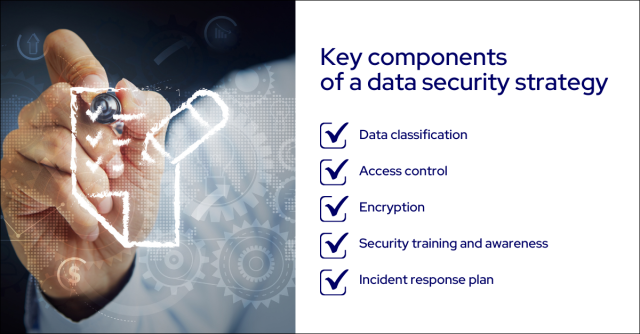How to build and maintain a data security strategy
In today's digital age, data security has become a critical aspect of safeguarding valuable digital assets. We have shared data security strategies you should know about, but do you know how to build and maintain a successful data security strategy at your organization? Read on to learn why you need a data security strategy, how to plan, implement, and maintain one, and, importantly, how to measure if it's working.

What is a data security strategy, and why do you need one?
A data security strategy is a comprehensive plan that outlines the steps, technologies, and best practices that organizations must implement to safeguard their sensitive information from unauthorized access, cyber threats, and breaches. A well-crafted data security strategy goes beyond reactionary measures; it encompasses a proactive approach to identifying vulnerabilities, implementing robust defenses, and responding effectively to potential breaches.
Handling any form of digital data requires a comprehensive data security strategy, as cyberattacks are becoming more frequent and sophisticated. Establishing this strategy is not a luxury but a necessity in the modern business landscape.
Now that we know we need one, let’s break down the key components of an effective data security strategy and how to get started building one at your organization.
Key components of a data security strategy
Creating an effective data security strategy requires a systematic approach that considers various components working in harmony. Let's explore the key components that form the foundation of a comprehensive data backup and recovery security strategy.
Component #1: Data classification
Begin by categorizing your data based on its sensitivity and criticality. Not all data is created equal, and this classification will help you allocate resources and apply security measures where they are most needed.
Component #2: Access control
Implement strict access controls to ensure that only authorized individuals can access sensitive data. This involves user authentication, role-based access, and continuous monitoring of data inventory and user activities.
Component #3: Encryption
Encryption is a cornerstone of data security. By encrypting data both in transit and at rest, you add an additional layer of data protection that makes it incredibly difficult for unauthorized parties to make sense of intercepted data.
Component #4: Security training and awareness
Your employees are your first line of defense. Provide comprehensive security training that educates your workforce about potential threats, best practices, and the critical role they play in maintaining data security.
Component #5: Incident response plan
Even with the most robust defenses, breaches can still occur. An incident response plan outlines the steps your organization will take in the event of a security incident. It defines roles, responsibilities, and procedures to minimize damage and facilitate a swift recovery.
How to plan your data security strategy to protect sensitive data
Planning a data security strategy is a meticulous process that requires a clear understanding of your organization's unique needs and vulnerabilities. Here's a step-by-step guide to help you navigate this critical phase.
-
Step #1: Identify assets and risks
Catalog all digital assets, including SPOFs, databases, applications, and hardware. Conduct a comprehensive risk assessment to identify potential vulnerabilities and threats associated with each asset. -
Step #2: Set security objectives
Establish clear and measurable data security policy objectives that align with your organization's overall goals. These objectives should reflect your commitment to data confidentiality, integrity, and availability. -
Step #3: Select appropriate technologies
Choose technologies and tools to protect data that align with your security objectives. This could involve deploying firewalls, intrusion detection systems, encryption solutions, and secure communication protocols. -
Step #4: Develop policies and procedures
Create comprehensive policies and procedures that detail how data should be handled, accessed, stored, and protected. These policies should cover everything from password backup and recovery to data protection management to data-sharing practices. -
Step #5: Regularly update and test
Data security is a dynamic field, and your strategy must evolve with the changing threat landscape. Regularly update your strategy to incorporate new technologies and best practices, and conduct routine testing and simulations to identify vulnerabilities.
How to effectively implement a data security strategy
Implementing a data security strategy requires careful planning and execution. Here's a roadmap to ensure a smooth and successful data protection strategy implementation process.
- Step #1: Gain executive support
Secure buy-in from senior leadership to ensure that your data security strategy receives the necessary resources, budget, and organizational support. - Step #2: Train your team
Equip your team with the knowledge and skills they need to execute the strategy effectively. This includes technical training, compliance education, and incident response drills. - Step #3: Gradual rollout
Implement the strategy in phases to minimize disruptions to operations. Start with critical assets and gradually extend security measures to cover the entire digital ecosystem. - Step #4: Monitor and fine-tune
Constantly monitor the effectiveness of your data security measures and be prepared to make adjustments based on emerging threats and changing business requirements. - Step #5: Foster a culture of security
Data security is not just a task; it's a mindset. Foster a culture of security within your organization by promoting awareness, accountability, and a shared commitment to safeguarding sensitive data.
Data security strategy maintenance
A data security strategy is not a one-time endeavor; it requires ongoing attention and maintenance to remain effective in the face of evolving threats.
Regularly revisit and update your strategy to incorporate new technologies, industry best practices, and lessons learned from security incidents. Keep your workforce informed and engaged through continuous training and awareness initiatives.
Measuring the effectiveness of your data security strategy with KPIs
Effectively measuring the success of your data security strategy involves tracking key metrics and Key Performance Indicators (KPIs) that reflect the strategy's impact on your organization's security posture.
Examples of key metrics/KPIs
-
Incident response time: Measure the time it takes to detect and respond to security incidents. A shorter response time indicates a more effective strategy.
-
Number of breaches: Monitor the frequency of data breaches and unauthorized access attempts. A decrease in this number signifies improved security.
-
Employee training completion: Track the percentage of employees who have completed data security training. A higher completion rate indicates a more informed workforce.
-
Vulnerability patching: Measure how quickly security vulnerabilities are identified and patched. Timely patching reduces the window of opportunity for attackers.
-
Data recovery time: Calculate the time it takes to recover data and resume normal operations after a breach. A shorter recovery time minimizes the impact of a breach.
Building a successful data protection strategy with Flexential
In the digital age, data security is not an option; it's a fundamental requirement for the success and sustainability of your business. A well-crafted data security strategy is your best defense against a wide range of cyber threats that can disrupt operations, compromise sensitive information, and damage your brand reputation. By understanding the importance of a robust data security strategy, recognizing potential threats, and taking proactive steps to safeguard your digital assets, you can navigate the complex landscape of data security with confidence.
Flexential expertise, advanced technologies, and comprehensive solutions offer a bridge to a more secure future. By partnering with Flexential, you're not just investing in data security; you're investing in the longevity and prosperity of your business in the digital age. Embrace the power of data security strategies today and embark on a journey toward fortified data protection and enduring success. Your digital future deserves nothing less.
Interested in learning how to protect your data in the future? Be sure to watch our webinar, "Continuous Data Protection Through 2030 and Beyond," where our experts explore cutting-edge solutions and strategies to safeguard your critical data against ransomware and downtime threats.







